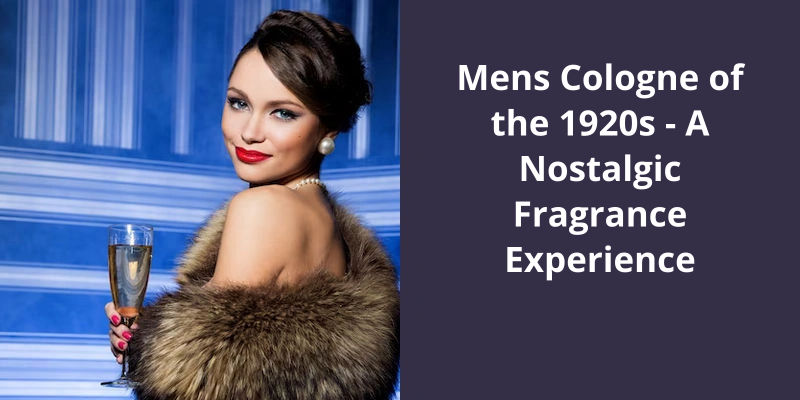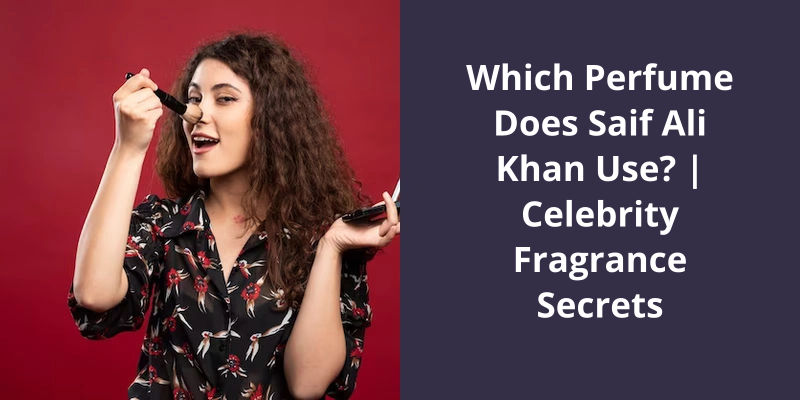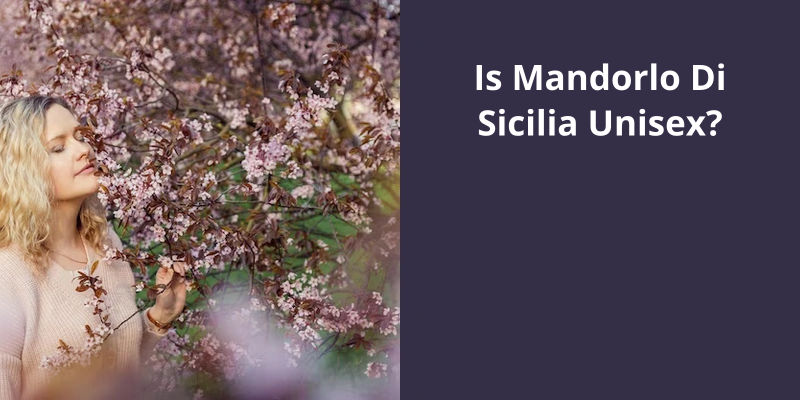Mens cologne of the 1920s was characterized by scents that represented the roaring decade’s spirit of change and progress. One of the most notable fragrances from this period is “Chanel No.5”, released by fashion house Chanel and created by perfumer Ernest Beaux. It was groundbreaking as it was one of the first perfumes to use aldehydes, which gave it a clean, radiant quality unlike traditional fragrances at the time. Furthermore, Guerlain’s “Shalimar” was another iconic fragrance, a symphony of vanilla and exotic floral notes that was pathbreaking for its sweet sensual character. Meanwhile, Houbigant’s “Fougere Royale”, first created in the late 19th century, also remained a popular choice among men in the 1920s for its woodsy, earthy blend of lavender, oakmoss, and coumarin. These perfumes dominated the decade, reflecting the bold, innovative spirit of the 1920s.

What Was the Most Popular Perfume in the 1920s?
During the 1920s, the world was undergoing a transformative time in fashion and beauty. Women were growing more independent and seeking to break free from traditional gender roles. This was reflected in new trends that swept the fashion industry, including flapper dresses and shorter hemlines. However, the most significant of these trends was the introduction of a new fragrance by Chanel in 1921.
Coco Chanel was already a prominent figure in the fashion world by the time she created No. She’d revolutionized womens fashion with her comfortable and practical designs that incorporated elements of mens clothing. However, she felt that something was missing – a scent that would embody the modern, independent woman. Using her keen business sense, she collaborated with perfumer Ernest Beaux to create a fragrance that was both complex and simple, using ingredients like jasmine, ylang-ylang, and patchouli.
The reaction to No. 5 was immediate and enthusiastic. Women all over the world wanted to experience the new scent that Chanel herself described as a “womans perfume with the scent of a woman.”. The combination of exotic ingredients and sleek packaging made it an instant classic. From Hollywood starlets to European royalty, everyone wanted to be associated with the Chanel brand.
Even today, No. 5 remains the worlds most iconic fragrance. It’s been worn by some of the most famous women in history, including Marilyn Monroe, who famously claimed to wear nothing to bed but a few drops of No. The fragrance has also been referenced in countless songs, films, and novels, cementing it’s place in popular culture.
One of the reasons No. 5 has endured for so long is it’s unique combination of sophistication and accessibility. While it was initially marketed as a luxury product, Chanels decision to sell it in smaller bottles at an affordable price opened it up to a wider market. This allowed women of all social classes to experience a bit of luxury in their everyday lives.
The History of Perfumes and Fragrance Development Before the 1920s.
- Ancient Egyptians used perfumes for religious ceremonies and as part of their daily grooming routine.
- The Greeks and Romans also used perfumes, often made from fragrant flowers and herbs, and many of their perfume recipes have been recorded.
- In the Middle Ages, perfumes were primarily used as incense to mask unpleasant odors.
- The first modern perfume was created in the late 1800s by a French perfumer named Francois Coty.
- During the Victorian era, perfumes became more popular as a luxury item and were often associated with the elite classes.
Perfumes have been a part of the human experience for centuries, and some have become timeless classics that still captivate us today. From Chanel Noº5 to Yves Saint Laurent Opium, these iconic fragrances have been woven into the fabric of our culture, inspiring generations of perfume lovers. Let’s take a closer look at what makes these scents so special and why they’ve endured for so long.
What Is the Most Classic Perfume of All Time?
There have been countless fragrances released over the years, but only a select few have truly stood the test of time to become true classics. Of all the iconic scents out there, Chanel Noº5 is perhaps the most synonymous with timeless elegance and sophistication. Since it’s creation in 1921 by legendary designer Coco Chanel, this fragrance has remained a staple in the world of high fashion and beauty. It’s unique blend of floral and musky notes has ensured that it continues to be celebrated by perfume enthusiasts and casual wearers alike.
Another classic fragrance that’s held it’s own over the years is Guerlain Shalimar. First introduced in 1925, this oriental fragrance boasts a complex blend of bergamot, iris, jasmine, and vanilla, providing a warm and sensual scent that’s remained popular for almost a century. It’s truly established itself as one of the most iconic fragrances of all time, with countless imitators and reinterpretations trying to capture it’s essence.
Nina Ricci LAir du Temps is another fragrance that’s stood the test of time. Originally released in 1948, this scent encapsulates the spirit of the post-war era with it’s soft and delicate floral notes. It’s unique blend of gardenia, jasmine, and violet has ensured that it remains popular with women of all ages, establishing itself as a true classic that’s still relevant today.
Yves Saint Laurent Opium is perhaps one of the most controversial fragrances to gain classic status. First released in 1977, it caused a stir with it’s provocative advertising campaign and it’s bold and exotic aroma. It’s blend of spicy oriental notes like clove and cinnamon, alongside floral accords like jasmine, has ensured it’s place as one of the most iconic fragrances of the 20th century.
Despite their differing origins and styles, each of these classic fragrances share a common thread: they’ve resonated with consumers for decades and continue to do so today. Whether it’s the timeless elegance of Chanel Noº5, the warm sensuality of Guerlain Shalimar, the delicate floral notes of Nina Ricci LAir du Temps, or the exotic spiciness of Yves Saint Laurent Opium, these fragrances speak to people on a deep emotional level and have become an integral part of many peoples lives.
It’s clear that the most iconic fragrances of all time are more than just scents – theyre reflections of our collective memories and experiences.
The History and Legacy of Each of the Mentioned Classic Fragrances
This topic explores the background and influence of well-known perfumes throughout history. It examines how these fragrances have affected the industry and how they’re still relevant today. The discussion focuses on the stories behind each scent, including their creators, inspirations, and distinctive characteristics. Not only does this offer insight into the beauty industry, but it also allows readers to appreciate the art and craft of perfumery.
As time goes by, trends and styles change, and this also applies to perfumes. However, amongst the many fragrances that have been launched throughout history, there are some that stand the test of time and remain popular even decades after they were initially released. For instance, Blue Grass by Elizabeth Arden is one of the perfumes that was a hit in the 1930s and continues to be cherished by many fragrance enthusiasts even today. Let’s take a closer look at what made Blue Grass such a sought-after scent back in the day.
What Perfume Was Popular in the 1930s?
In the early 1930s, perfume was considered a luxury item that only the wealthy could afford. However, the economic downturn following the Great Depression saw a shift in consumer behavior, driving the rise of affordable perfumes. This period saw a new wave of scents, predominantly featuring floral notes, that captivated the market. Many of these scents are still popular today due to their unique and enduring appeal.
One of the most memorable fragrances of the time was Blue Grass by Elizabeth Arden. Launched in the mid-1930s, the scent was inspired by the rolling hills of Virginia and featured a blend of lavender, jasmine, musk, and rose. It’s refreshing and delicate aroma made it a hit among women, and it’s stood the test of time as one of Ardens most popular fragrances.
Other popular scents of the era included Chanel No. 5, which was created in 1921 but gained popularity in the 1930s due to it’s association with celebrities such as Marilyn Monroe. This scent was unique in that it contained over 80 different fragrant ingredients, producing a rich, complex aroma.
Joy by Jean Patou was another hit fragrance of the 1930s which remains popular to this day. The scent was famously worn by actress Jean Harlow and featured a blend of floral essences including jasmine, rose, and tuberose. Similarly, Aliage by Estée Lauder was introduced in 1972 but was inspired by the classic scents of the 1930s.
The 1930s also saw the rise of perfumes that catered specifically to men. One such scent was Acqua di Parmas Colonia, which launched in 1930 and became popular amongst Italian aristocrats. Colonias base notes of lavender and rosemary, with hints of citrus, proved a hit, and the brand remains a popular choice today.
Finally, LAir du Temps by Nina Ricci, first launched in 1948 but inspired by the scents of the 1930s, was another enduring fragrance popularised during this period. It featured a blend of gardenia, jasmine, and rose, with a slightly spicy undertone, and remains a classic scent to this day.
The 1930s saw a new wave of fragrances entering the market, and many of these scents have remained popular to this day. From Blue Grass by Elizabeth Arden to Chanel No. 5 and LAir du Temps by Nina Ricci, these fragrances continue to captivate audiences with their unique and timeless appeal.
The Influence of Art Deco Design on Perfume Bottle and Packaging Design During the 1930s
- The Art Deco movement emerged in the 1920s and reached it’s peak in the 1930s.
- It was characterized by geometric shapes, bold colors, and a streamlined, modern aesthetic.
- This design style had a significant influence on the development of perfume bottle and packaging design during the 1930s.
- Perfume bottles became more decorative and ornate, with intricate geometric shapes and bold, stylized designs.
- Many of the top perfume houses of the time, such as Chanel and Guerlain, embraced this style and incorporated it into their branding and packaging.
- The use of materials such as glass, metal, and Bakelite allowed for new shapes and designs to be created.
- The Art Deco influence can still be seen in modern perfume bottle and packaging design, as it’s become a timeless and classic style.
Source: Vintage perfumes: scents from the 20s, 30s and 40s Blog
Vintage perfumes have a charm and sophistication to them that make them timeless classics. From floral scents to warm vanilla fragrances, there are a plethora of vintage perfumes that have stood the test of time. Let’s take a closer look at some of the most popular vintage perfumes that are still in demand today.
What Are the Most Popular Vintage Perfumes?
The world of perfumes is vast and diverse, encompassing countless brands, scents, and styles. However, among the vast array of options, vintage perfumes stand out as particularly unique and beloved. These fragrances from past decades offer a whiff of nostalgia and elegance, transporting us back in time to the era of their creation.
One such popular vintage perfume is Samsara parfum from Guerlain Paris. Launched in 1992, this scent is steeped in the traditions of the French perfume house, offering a rich and heady blend of sandalwood, jasmine, and ylang-ylang. It’s exotic and sensual appeal has made it a timeless classic and a favorite among perfume enthusiasts.
Another notable vintage perfume is Spellbound from Estee Lauder. Released in 1991, this scent embodies the glamorous and bold spirit of the 90s. It’s powerful combination of vanilla, orchid, and amber speaks to a sense of confidence and allure, making it a popular choice for those seeking a signature scent.
Sunflowers vintage fragrance from Elizabeth Arden is also a beloved classic. Created in 1993, this perfume epitomizes the freshness and simplicity of the floral scents that were popular in the 90s. It’s blend of bergamot, melon, and peach creates a light and refreshing aroma that’s perfect for everyday wear.
Tribu from Benetton is another popular vintage perfume hailing from 199This scent is characterized by it’s earthy and woody notes, which evoke a sense of groundedness and calm. It’s blend of green apple, peach, and sandalwood creates a complex and intriguing aroma that’s won over many fans.
Truly Lace perfume is another vintage fragrance that’s stood the test of time. Created in 1993, this perfume offers a sweet and feminine scent, characterized by it’s notes of peony, rose, and peach. It’s light and airy aroma has made it a favorite of many women over the years.
Finally, Venezia eau de toilette by Laura Biagotti is a popular vintage perfume that embodies the romantic and luxurious spirit of Venice. Released in 1993, this scent offers a rich and indulgent blend of amber, vanilla, and patchouli. It’s warm and alluring aroma is perfect for those seeking a refined and sophisticated fragrance.
How to Properly Store Vintage Perfumes
- Avoid direct sunlight and store in a dark, cool place
- Keep the perfume bottle upright to prevent leakage or evaporation
- Avoid storing in damp areas such as bathrooms
- Keep the perfume away from strong odors such as household cleaners or food
- Store the perfume in it’s original packaging or a dark, opaque container
- Avoid frequent exposure to air by not opening the bottle unnecessarily
Conclusion
In conclusion, the world of men's fragrance in the 1920s was characterized by a diverse range of scents, each with their unique characteristics and appeal. From the rich and masculine leather and tobacco-based fragrances to the refreshing and citrusy aromas, men had a plethora of options to choose from. Today, many of the classic fragrances from the 1920s still remain popular, demonstrating their timeless appeal and enduring quality.





